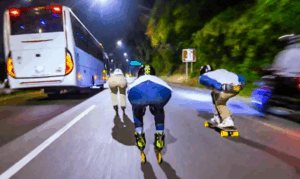Inline skating, once a defining trend of the 1990s, is rolling back into popularity with a fresh, modern twist. Once synonymous with neon windbreakers, skate parks, and weekend strolls down boardwalks, the sport has re-emerged as a favorite pastime for fitness enthusiasts, urban commuters, and families alike. What was once seen as a nostalgic throwback to the rollerblading boom is now a full-fledged movement—blending fitness, recreation, and community in a way that fits perfectly into today’s active, health-conscious lifestyle.
The Rise Of The 90’s
In the 1990s, inline skating exploded across cities and suburbs worldwide. It combined the excitement of skateboarding with the accessibility of jogging or cycling, appealing to people of all ages. Inline skates became a symbol of freedom and individuality, offering a fun way to stay fit while cruising down sidewalks or gliding through parks. Skating competitions, aggressive skating videos, and even blockbuster movies helped define the decade’s energetic culture. But by the early 2000s, the trend began to decline. The rise of other sports, shifting fashion, and the dominance of team-based fitness activities gradually pushed rollerblading to the sidelines.
Millennial Comeback
Fast forward to today, and inline skating is making a powerful comeback. This resurgence has been fueled by social media, where skaters share clips of tricks, fitness routines, and city explorations u
nder hashtags like #RollerbladingIsBack. Advances in skate design—lighter frames, smoother bearings, and more supportive boots—have also drawn newcomers. Inline skating now sits comfortably at the intersection of fitness and leisure: it’s low-impact, easy to learn, and perfect for urban environments where space may be limited.

Inline Adaptability
One of the key reasons for inline skating’s renewed popularity is its adaptability to different living situations. Whether someone lives in a suburban house, a city condo, or an urban apartment complex, skating offers a convenient way to get outside and stay active. For example, residents of Water Mark Apartments, known for their modern amenities and open community spaces, often find skating to be an ideal form of recreation. Smooth pathways, nearby parks, and secure storage options for gear make it easy for apartment dwellers to embrace this growing trend. Inline skating can be enjoyed solo or with friends, making it a social activity that fits naturally into everyday life—even for those with limited outdoor space.

Beyond fitness, skating fosters community connection. Group skates, outdoor events, and local meetups are bringing together people of all ages, reminiscent of the social energy of the 1990s. Many cities have also invested in better paths and recreational areas, giving skaters safe and scenic places to ride. The sport’s revival highlights a broader cultural shift toward nostalgic yet mindful recreation—activities that blend movement, fun, and personal freedom.
As inline skating rolls confidently into its new era, it’s clear that this once-iconic pastime has found lasting relevance. From neighborhood streets to apartment complexes like Water Mark Apartments, skating’s versatility and accessibility make it more than just a comeback—it’s a reawakening of a lifestyle built on motion, balance, and pure joy.
